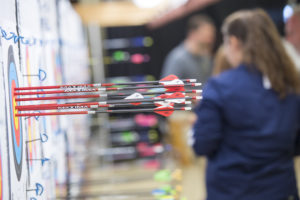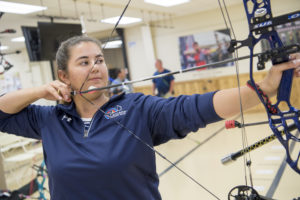You’d think arrow points made for target archery would be universal across all disciplines. All a point has to do is punch a hole through the target so the arrow can stick, right?
Arrow points are more than just pointed pieces of metal. They are an integral part of the arrow setup, and they have a lot to do with how that arrow performs. They come in a variety of shapes and sizes, based on the size of the arrow they’re being paired with and the type of target being shot.
Arrows come in different sizes. There are super-skinny shafts, like the Easton X-10, which can have an outside diameter of .176 inches, and there are fat arrows, like the Black Eagle PS27, which can have an outside diameter of .420 inches.
The arrow point is meant to fit snugly inside an arrow shaft or insert and match the outside diameter. You should be able to run your fingers down the end of an arrow and feel a smooth transition to the point. A point that’s too skinny can cause penetration problems, and a point that’s too big around can be difficult to remove from a target.
Target archery points can be either glued or screwed into place inside the shaft. If the shafts have point inserts installed in them, then the points will be screw-ins. These make changing points a snap. If there is no point insert, then the points will have to be glued in place.
For target penetration, there is no real performance difference between glue-ins and screw-ins. There are more options in sizes, shapes and weights for glue-in points compared with screw-ins. Some arrows, like the super-skinny arrows shot by recurve and outdoor compound archers, only accept glue-in points.
Points that are long and very sharp are favored by 3D target archers, who are trying to minimize glance outs. Those occur when an arrow slams into the back of another and deflects away from it. Slender, “pointy” points tend not to deflect as badly as shorter, larger-diameter points. Outdoor target archers shooting long distance also tend to prefer narrow points because they’re more aerodynamic.
Blunter, more rounded target points are favored by indoor archers who are trying to catch scoring rings. All an arrow has to do is touch the very outer edge of a scoring ring to earn the points awarded by that ring, and bigger-around points increase the odds of catching that ring.
Arguably the most technical aspect of an arrow point is its weight. The weight of the point goes a long way in dictating performance of the arrow. It affects the spine of the arrow, which is how much it flexes. Arrow manufacturers recommend certain arrow spines depending on the arrow’s length, the draw weight of the bow and the weight of the point. The heavier a point is, the more it weakens an arrow’s spine. Conversely, lighter points result in stiffer arrows.
Think of neutral as being an arrow with a 100-grain point. The basic spine recommendation on all spine charts from arrow manufacturers assumes a 100-grain point. An arrow in the correct spine with a 100-grain point will perform well for archers in a range of activities.
Go heavier and an arrow will fly slower but will likely resist wind better. Go lighter and an arrow will fly faster but will likely drift more in the wind.
Target archers typically opt for points that are heavier than normal — from 140 grains to 300 grains — because the momentum of the heavier point helps pull the arrow through the air. An arrow with a heavier point tends to stay on course better than one with a lighter point.
The trick is to go heavy enough with points, without going too heavy. There are some arrow points that allow archers to fine-tune the weight with sections that can be added or removed to increase or lower the overall point weight. Arrow grouping is a great way to decide what point weight works best. Tight groups mean repeatable precision from an arrow setup. Groups that are more open indicate arrow performance that is not quite as precise.
You’ll typically see the heaviest points — those weighing 200 to 300 grains — in indoor archery. The wind in this instance is more relevant to the arrows rather than the points and the shooting distance is a constant 20 yards. Those heavy points usually are placed in large-diameter arrows, which are most common in indoor target archery. Archers in this setting don’t mind shooting big, heavy, slow arrows because the distance is short and constant, and there is no wind.
Choosing the right point for target archery requires more thought than just finding the one that fits your arrows. Figuring out which style produces the best results for you could take some time and testing, but you might see impressive improvements in your performance as a result.



